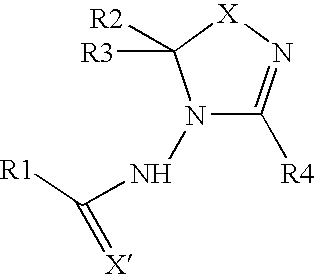Oxadiazoline ligands for modulating the expression of exogenous genes via an ecdysone receptor complex
a technology of ecdysone receptor and oxadiazoline, which is applied in the field of gene expression and non-steroidal ligands, can solve the problems of system leakage, limited use of pr1-a, and system limitations
- Summary
- Abstract
- Description
- Claims
- Application Information
AI Technical Summary
Problems solved by technology
Method used
Image
Examples
example 1
Preparation of Compounds
[0287]The compounds of the present invention may be made according to the following synthesis routes.
1.1 Preparation of Isopropylidene-hydrazine
[0288]
[0289]A 500 mL 3-neck flask was fitted with a mechanical stirrer, thermometer, and addition funnel. The vessel was charged with 140 mL of methanol, and then cooled to −5° C. in an ice / salt bath. BaO (7.5 g, 50 mmole) was then added portion-wise over 5 minutes. Gas evolution and an exotherm were observed. A maximum temperature of 5° C. was reached. The reaction was cooled down to 0° C., and hydrazine monohydrate (32 g, 0.64 moles) was added in one portion, causing the mixture to warm to 5° C. The vessel was cooled down to 0° C. and the mixture was stirred for 10 minutes. A solution of acetone (37 g, 0.64 moles) in 40 mL of methanol was added drop-wise over 1 hour at 5° C. Stirring was continued, allowing the reaction to warm slowly to room temperature. Stirring was continued overnight, but if the reaction was all...
example 2
Biological Testing of Compounds
[0384]The ligands of the present invention are useful in various applications including gene therapy, expression of proteins of interest in host cells, production of transgenic organisms, and cell-based assays.
27-63 Assay
[0385]GAL4 DBD (1-147)-CƒEcR(DEF) / VP16AD-βRXREF-LmUSPEF: The wild-type D, E, and F domains from spruce budworm Choristoneura fumiferana EcR (“CfEcR-DEF”; SEQ ID NO: 1) were fused to a GAL4 DNA binding domain (“Gal4DBD1-147”; SEQ ID NO: 2) and placed under the control of a phosphoglycerate kinase promoter (“PGK”; SEQ ID NO: 3). Helices 1 through 8 of the EF domains from Homo sapiens RXRβ (“HsRXRβ-EF”; nucleotides 1-465 of SEQ ID NO: 4) and helices 9 through 12 of the EF domains of Locusta migratoria Ultraspiracle Protein (“LmUSP-EF”; nucleotides 403-630 of SEQ ID NO: 5) were fused to the transactivation domain from VP16 (“VP16AD”; SEQ ID NO: 6) and placed under the control of an elongation factor-1α promoter (“EF...
example 3
Insecticidal Activity of Compounds
[0402]The compound to be evaluated was dissolved in an appropriate solvent, usually a mix of acetone, methanol, and water. Test solutions were made by serial dilution of a stock test solution with acetone, methanol, and water. Initial evaluations were made at one or more concentrations on one or more of the following insects:
[0403]
Code SymbolCommon NameLatin NameBAWBeet ArmywormSpodoptera exiguaCLCabbage LooperTrichoplusia niTBWTobacco BudwormHeliothis virescens
[0404]Feeding bioassays were conducted in bioassay trays containing insect diet. Treatments were made by applying 50 μL of test solution to the surface of the diet in each of 5 wells. After the test solution dried, each well was infested with a single neonate larva. The trays were held for six days and then the mortality rating was determined for each treatment.
[0405]Contact bioassays (green peach aphid, two-spotted spider mite, white fly) were conducted by applying a solution of the test com...
PUM
| Property | Measurement | Unit |
|---|---|---|
| Electrical inductance | aaaaa | aaaaa |
Abstract
Description
Claims
Application Information
 Login to View More
Login to View More - R&D
- Intellectual Property
- Life Sciences
- Materials
- Tech Scout
- Unparalleled Data Quality
- Higher Quality Content
- 60% Fewer Hallucinations
Browse by: Latest US Patents, China's latest patents, Technical Efficacy Thesaurus, Application Domain, Technology Topic, Popular Technical Reports.
© 2025 PatSnap. All rights reserved.Legal|Privacy policy|Modern Slavery Act Transparency Statement|Sitemap|About US| Contact US: help@patsnap.com



